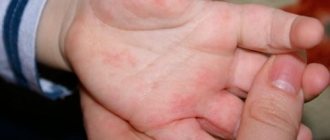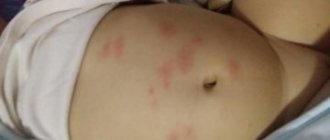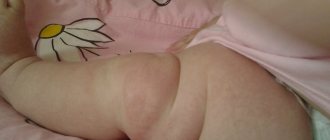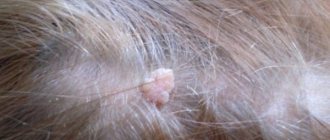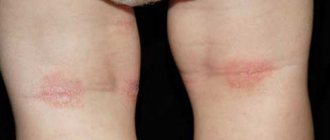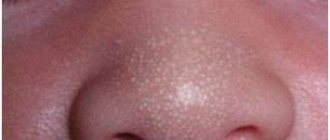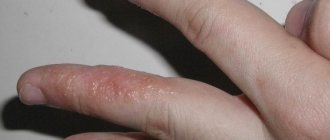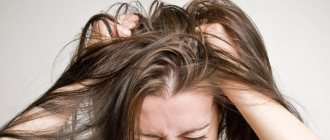Varieties and their symptoms
It is difficult to independently determine the cause of a rash on a child’s face. Pimples can appear at different ages. Some of them are localized on the face. Others can affect the head, neck, and torso.
For an accurate diagnosis, an examination by a doctor is required. The pediatrician will prescribe additional examinations. It is important to pay attention to external manifestations.
A significant role is played by:
- location;
- extent of skin damage;
- the presence of accompanying symptoms (itching, burning, pain);
- size of rashes;
- the presence of inflammation or abscess;
- general well-being.
Experts identify several types of rashes that affect the face. Some of them require close monitoring and drug therapy.
The School of Dr. Komarovsky will tell you about different types of rashes:
Prickly heat
A child's sweat glands are imperfect. Because of this, thermoregulation processes in children do not proceed the same way as in adults. Miliaria is one of the most common causes of rash.
It is difficult to distinguish it from other conditions on your own. Difficulties with differentiation are associated with the presence of several varieties.
- Miliaria rubra. The surface of the skin changes color. In severe cases, it turns bright pink. Rashes form with cloudy contents inside. A red tint to the epidermis indicates inflammation.
- Crystalline prickly heat. A large number of bubbles with transparent contents form on the skin. When touched and pressed, they burst easily. There is no redness with this form.
- Papular miliaria. It manifests itself as a pinpoint rash on the face and body. It can form quite large accumulations on the skin.
- Infected heat rash. This is a complicated option. The diagnosis is made if microbes enter the wound formed when the vesicle ruptures. Bacteria provoke an inflammatory process.
Possible suppuration of the affected area , deterioration of health, rise in temperature.
The rash appears due to problems with the functioning of the sweat glands. Prickly heat can be caused by various factors. The main ones are:
- indoor humidity;
- lack of hygiene;
- excessive insulation of the child;
- use of synthetic underwear and clothing.
Miliaria affects not only the face. Often the rash appears on the neck, armpits, shoulders, and then spreads throughout the body.
If the condition is not complicated by infection, the child feels normal. Pimples do not cause discomfort and do not cause itching.
Miliaria is a disease of newborns. What do you need to know? Watch the video about this:
Allergic reactions
During the first year of life, a baby actively gets acquainted with new foods. After 6 months, it is recommended to introduce complementary foods. Before this, he receives breast milk or formula.
The digestive system continues to develop after birth. Any unsuitable product may cause an allergic reaction. Attentive parents will notice the appearance of a characteristic rash on the baby’s face.
Such rashes are a manifestation of the body’s immune reaction in response to irritants. Among the allergens:
- food products;
- wool;
- dust;
- medicines;
- cosmetics;
- household chemicals;
- pollen.
Most often, allergic dermatitis is observed with the introduction of complementary foods. If the baby is breastfed, then the reason will be a violation of the mother's diet.
A rash caused by food allergens is most often localized on the cheeks and chin .
There may be redness in these areas of the skin, but no pimples. The baby is bothered by severe itching.
People often ask: does Linex help with diarrhea in a child? How and how much to give the medicine? Our publication will provide answers to questions.
Read about the symptoms and treatment of atopic dermatitis in children in this article.
Symptoms and treatment of acute adenoiditis in a child are discussed in this material.
Newborn acne
Not all facial rashes require treatment. Newborn acne goes away on its own.
The appearance of a strong, small red rash on the face of a month-old baby, like pimples, can frighten parents. These rashes are hormonal in nature. Every fifth child is susceptible to their development.
Acne is localized mainly on the face. Pimples cover the forehead, nose, chin and cheeks. Some of them are filled with purulent contents. Dermatologists call them pustules. In appearance they are close to teenage acne.
Acne does not cause discomfort. Pimples do not cause itching. In most children, this phenomenon disappears on its own at 2-3 months. In rare cases, rashes persist for up to 1.5 years. Then we talk about baby acne.
Small white nodules on the baby’s nose or under the eyes should not cause concern. Many babies are born with milia on their face.
These rashes are associated with blockage of the sebaceous ducts . They also go away without treatment.
Doctor Komarovsky's school will talk about rashes in newborns:
Erythema toxicum
Newborn babies gradually adapt to their environment. During adaptation, a restructuring of all body systems occurs.
The child learns to eat and breathe differently.
During the period of perestroika, red pimples often appear on the face; they have gray heads. The rash affects the face and scalp.
Erythema toxicum is not dangerous. The rash goes away within a few days.
Infectious diseases
Older children are also more likely to develop rashes. Parents should be careful, as pimples may indicate an infection.
- Chicken pox.
This is a viral disease, which is characterized by the appearance of red lumps on the skin. Rash on the face and body. The spots transform into bubbles. The latter burst and a crust appears. With chickenpox, your body temperature rises. Possible enlarged lymph nodes. - Rubella. The rash can be either large or small. The child is showing signs of ARVI. Your throat may hurt. Its mucous membranes usually turn red and swell.
Rubella rashes disappear after 5 days. During this period, a slight rise in temperature is possible.- Scarlet fever. When the disease occurs, pimples appear on the face and then spread throughout the body. They are bright red in color and noticeably rise above the skin. The temperature rises, signs of a sore throat appear.
- Measles.
This viral disease is always severe. Pink spots appear in the early stages. The predominant place of their localization is the forehead. Further, the spots merge into large formations . Symptoms other than a rash on the face may be observed: runny nose, cough, diarrhea, headache, temperature rises to 40 degrees.
A distinctive feature of any infectious disease is an increase in temperature.
Children's viral infections are easily transmitted by airborne droplets. The same disease does not develop twice. The child develops a strong immunity to any of the infections.
Types of rashes in newborns
The first 4 weeks after birth are considered the neonatal period.
The skin of a newborn baby has not yet fully developed, so it is too tender and susceptible. In addition, this is the largest surface that is in contact with the outside world.
Any influences from the external environment and various processes occurring in a small organism will cause different reactions on the skin.
These can be various types of rashes on the skin of a newborn:
- spots – pink, red, white;
- papules - in the form of nodules or tubercles;
- plaques - thickenings, compactions that rise above the skin level;
- blisters - with swelling of the dermal papillae, dense formations;
- bubbles – exudative elements;
- pustules - blisters with purulent contents.
Newborn babies experience the following skin diseases:
- toxic erythema;
- acne of newborns;
- prickly heat.
With toxic erythema, a rash of reddish, dense spots appears on the baby’s skin, dotted with small blisters filled with exudate (see photo).
They usually cover the folds of the arms or legs, neck, buttocks, and chest.
With severe rashes, the lymph nodes become enlarged. Treatment is prescribed by a doctor.
It has been noticed that if a nursing mother changes her diet, everything returns to normal for the child.
The nurse should exclude from her diet:
Newborn acne or infant acne looks like single nodules or blisters filled with a yellowish-light liquid (see photo).
These rashes are associated with problems with the skin follicles or sebaceous glands.
Pimples do not merge, do not cause itching, and are easy to distinguish from other diseases.
Increased hygiene care is required to avoid secondary infection.
With heat rash in newborns, a reddish or pink small rash appears in areas that are most susceptible to sweating (see photo).
These are all folds, areas of the buttocks, legs, arms, neck.
Small bubbles with liquid usually appear if the baby is wrapped tightly or the rules of hygiene and care are not followed.
Video about childhood rash from Dr. Komarovsky:
Is it necessary to treat the baby and how?
Parents are interested in how to treat a rash on their child’s face. The pediatrician will answer their questions. The treatment regimen is selected individually, taking into account the causes of the rash.
Treatment is not always necessary. Sometimes the rash goes away on its own.
If the rash is allergic in nature, the influence of the provoking factor must be eliminated. A nursing mother should reconsider her diet.
The following are excluded from the diet:
- chocolate;
- citrus;
- Exotic fruits;
- red fruits;
- dairy products;
- spices.
Be careful when including fish and chicken in your diet. They are also considered potential allergens. Each new product is introduced to the menu carefully , observing the baby's reaction.
When introducing a child to new food, strict rules are followed. Your pediatrician will tell you about the specifics of introducing complementary foods.
Treatment of prickly heat does not cause difficulties for parents. It is important to maintain good hygiene. It is necessary to bathe the baby regularly. Decoctions of herbs - string or chamomile - are added to the water.
For severe rashes, antihistamines must be taken. The choice of drug is made by the doctor. Suprastin is most often recommended for children.
To eliminate peeling, you can use healing non-hormonal ointments. The drugs Bepanten and D-Panthenol have good reviews.
If a rash appears against the background of an elevated temperature, you should consult a doctor. In severe cases, hospitalization will be required.
Doctors usually prescribe antibiotics or antiviral drugs depending on the type of pathogen. Other medications are designed to relieve symptoms and make the child feel better.
If you want to know whether it is necessary to remove adenoids in children, read our article.
You can learn about the treatment of diathesis in children from this publication.
What should you do if your child has ear pain and a fever? We'll tell you! Find out more in this post.
How to treat rash in newborns
You should definitely invite a pediatrician to see your child and follow all the recommendations the doctor gives. Treatment usually consists of taking antiviral, antihistamine and antipyretic medications .
Allergic rashes are treated at home, but with constant monitoring by a dermatologist and immunologist. The main thing that parents must do is to remove all provoking stimuli from the child’s environment. The affected skin is regularly treated with drying creams .
At the same time, great attention is paid not only to eliminating the pathogen and healing pustules, but also to normalizing the functioning of the digestive tract. This helps prevent serious complications and quickly survive the acute period of the disease.
source
What not to do
Parents find it difficult to cure the rash. Therapy can indeed be lengthy. However, compliance with a number of requirements significantly speeds up treatment. The doctor will tell you what not to do when getting rid of the rash.
It is unacceptable to squeeze out pimples that appear . This does not affect the rate of healing, but will open the door to infection.
Rashes in newborns should not be treated with alcohol-containing liquids. Their skin is too sensitive. This may cause a burn.
Overheating must not be allowed. The thermoregulation system is not formed. Therefore, the baby is dressed so that he does not feel hot. It is better to use vests and diapers made from natural fabrics.
These are instructions for parents on what to do if their baby is a month old or older and has a rash on the face, around the mouth or on the head, arms and stomach.
If any rash appears, it is better to show the baby to the pediatrician. This will eliminate doubts about the correctness of the diagnosis. If necessary, the doctor will order tests and recommend medications.
Causes of the rash
Miliaria is the most common rash in infants.
This rash is localized in the area under the diaper and in skin folds. Visually, it resembles small bubbles, around which redness is noticeable. In most cases, prickly heat occurs when the diaper is not changed in a timely manner, or due to overheating, if the baby sweats in too warm clothes. Inflammation occurs from excess moisture in which bacteria actively multiply.
Therefore, the first aid for prickly heat is to cleanse the skin and allow it to breathe and remain dry. Pharmacies today offer many drying creams for children's skin.
Timely hygiene, clothing appropriate for the weather and the use of special care products will be the best prevention in the fight against prickly heat.

